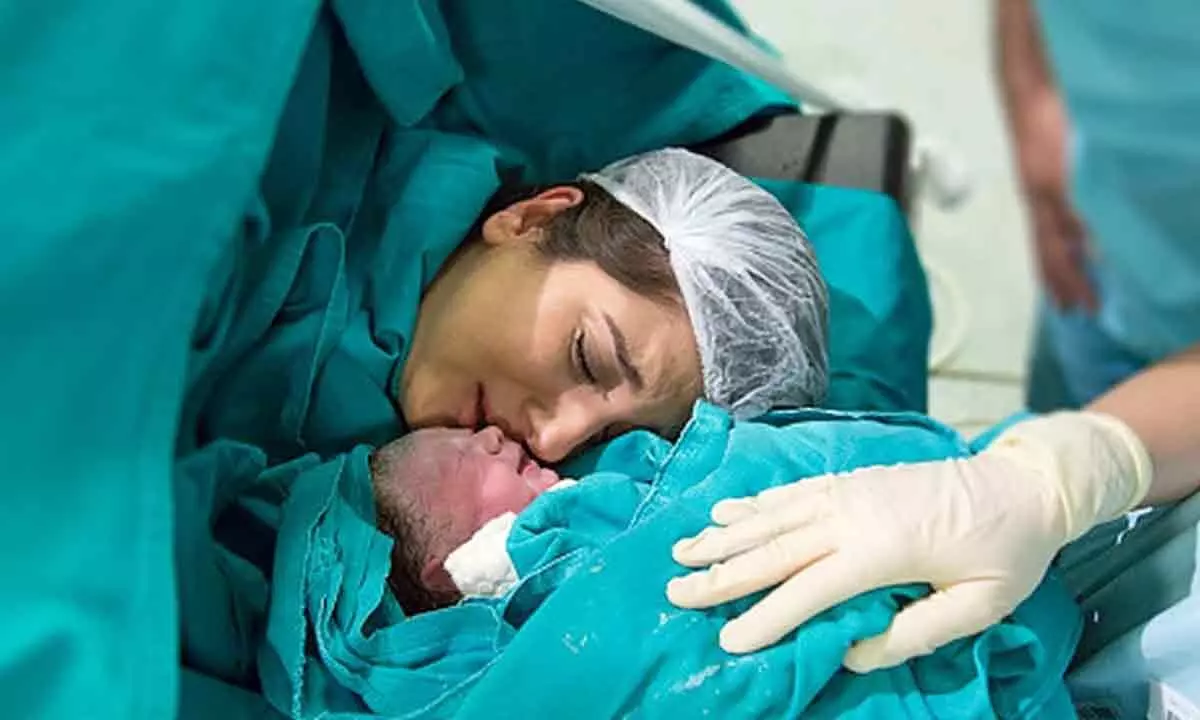Rise in caesarean births is a reason to be worried about

Representational Image
A large number of women go for Caesarean section (C-section) deliveries although they medically don’t require one.
Bengaluru: A large number of women go for Caesarean section (C-section) deliveries although they medically don't require one. A study conducted by the NFHS (National Family Health Survey) has revealed that one in five pregnant women go through C-sections even when it isn't medically required. Experts say that there might be a possibility of risks in the future for the mother and the baby.
The World Health Organisation (WHO) has laid down certain guidelines where the caesarean procedure should only be performed when there are complications. However, the latest study shows that India has crossed the threshold of 15% when it comes to caesarean births. The cause for concern is that both urban and rural areas have been witnessing a rapid increase in C-section births.
"It's becoming more common in urban areas though rural areas aren't behind. In rural areas, there are mushrooming private hospitals and most of them believe in performing Caesarean sections which the rural women are getting used to," says Dr Latha Venkataram, Obstetrician and Gynaecologist, Rangadore Memorial Hospital.
Reasons for an upsurge in caesarean births
"In recent years the rate of C-Section births has increased due to various reasons such as increased maternal age at the time of first conception mainly in urban areas and due to patient preferences," says Dr Geetha Veerappa Komar, Consultant – Obstetrics and Gynaecology, Manipal Hospital.
"As the urban areas are mostly associated with diseases such as maternal obesity, uncontrolled gestational diabetes mellitus resulting in big baby, sedentary lifestyle throughout the pregnancy, associated hypertension in some cases, the number of C-Section deliveries have increased," she adds.
"There are a few reasons for rising C-Section deliveries over the past few years. If there are providers, there are takers and vice versa," Dr Latha said putting the grim reality in a nutshell.
From a patient's perspective
"From a patient's point of view, they have this myth dwelling in their minds that they don't have to go through a lot of pain and is considered an easy option which isn't the case. People are becoming more and more dependent on horoscope, where they have a specific date and time for the child's birth. They also tend to believe that it is safe for the infant where the baby won't be challenged. There are some women who feel too posh to push. Both the structure of the family and the society has transformed completely and the experienced elders' opinions are not well taken. We mostly come across nuclear families and people assume that they know everything as they have access to information which isn't processed into knowledge/wisdom. Hence, there are numerous misgivings regarding the mode of delivery especially in India. Another point is that people prefer a particular doctor and a hospital as they care for the ambience, and the doctor. It is unfortunate that they don't realise that a specialist cannot be available with the same efficiency 24/7 unless they program the delivery, otherwise there can be an increase in Caesarean sections," explains Dr Latha.
From a doctor's perspective
"From a doctor's point of view, every labour takes about 12-16 hours if they don't interfere much with nature. During labour one has to make sure that there is an availability of anaesthetists, operating theatres, staff for monitoring the baby and the mother. This can be difficult and taxing to the obstetricians since there can be dearth of efficient junior doctors/staff to monitor labours. Hence, the doctor might find it unsafe to let the lady go for a vaginal delivery," Dr Lata explains
"It is an easy option for doctors to perform caesarean deliveries as they require 30 minutes. Following evidence-based protocols as indications for C-section, is not widely practiced. Hence, many of them consider indications like head not getting fixed, cord round the neck, and so on as indications for C-section. People use indications which are not scientifically correct, very liberally. An audit from Kerala reflects that the maximum number of sections performed are between 8-9 in the morning, and 3-5 in the afternoon as it coincides with the convenient time for the specialists. Medicolegally, C-sections are less sued compared to vaginal deliveries as people think that something ultimate has been done although it is the other way round. The specialists feel that they could be medicolegally safer for them to perform C-sections," she adds.
When is a caesarean recommended?
"High risk pregnancy cases such as eclampsia, pre-eclampsia, uncontrolled gestational diabetes mellitus with babies being much larger than average, cephalopelvic disproportion which occurs when there is mismatch between the size of the foetal head and size of the maternal pelvis, resulting in "failure to progress" in labour for mechanical reasons. Previous history of abdominal scar running the risk of rupture during active labour. Obstructed, prolonged non-progress of labour. Foetal distress running risks of Meconium aspiration syndrome (Meconium aspiration syndrome occurs when a new-born breathes a mixture of meconium and amniotic fluid into the lungs around the time of delivery)," says Dr Geetha Veerappa Komar.
Why is it important for a vaginal birth to take place?
A major benefit of a natural birth is beneficial bacteria which helps in building up the baby's immunity. "The baby passing through the birth canal is extremely vital for the gut programming as it is the first time where the baby is being exposed to bacteria. The gut microbiomes get programmed and this is probably why nature takes time to pass through one foot of bony canal. This programming forms 80% of immunity for the individual and most people aren't aware of this. As gut is the second brain, while it is being programmed, the neurotransmitters communicate with the brain which affects the intelligence, behaviour, etc. It is very important to know that a baby traversing through the pelvis will be physically and mentally healthy. Unfortunately, if this is surpassed, one cannot compensate for it by any other means," explains Dr Latha.
"If people can be rightly educated about how it is important to not go against nature, how vital it is for their babies to get programmed well, this may reduce. The complete purpose of producing a progeny is to enjoy having a healthy individual as their baby. I wouldn't say that the purpose is completely defeated, but by misgivings and misunderstandings they are not giving their best to get the best," she expresses.
Caesarean sections do not come without risks
Women who give birth by caesarean may face health risks in the future which is also the case for children born by caesarean. "There are anaesthetic risks as well as surgical risks. I'm not speaking about indicated caesareans which includes obstructed labour. The indications for caesarean should not cross 15% according to the WHO (World Health Organisation. Nevertheless, the ratio has been reversed here where 15% normal deliveries and 85% Caesarean sections are performed. In developed countries where they come across pregnancies with advanced maternal age, 35% is the maximum number of caesarean sections performed. People are falling head over heels to reduce the number of caesareans as it isn't good for the baby," she reveals.
"Another reason for why the numbers are going up is that if the first delivery was a caesarean, nobody would want the scars to open up during the second pregnancy and labour. When one isn't prepared to deliver the baby vaginally during the first birth, how can you expect a vaginal birth after a caesarean? With the primary caesareans going up, the secondary caesareans are invariable. Once the lady has had a caesarean section, the next time they open her up for any reason, there are six times more chances of infection, bleeding, healing problems, and pain. Surgical options should not be taken unnecessarily or must be considered as the last resort," she adds.
At the end of the day, both the mother and the baby will be benefited through a natural birth. "It is extremely important to maintain the quality of life for the woman and the baby. Babies born out of caesarean have higher chances of getting admitted to the Neo-natal unit. As obstetricians, we should give our best for them to get the best and as patients, they should give their best to get the best. People should learn to move along with nature as anything against nature will take a tour, and this has been witnessed in many different ways," she concludes.














